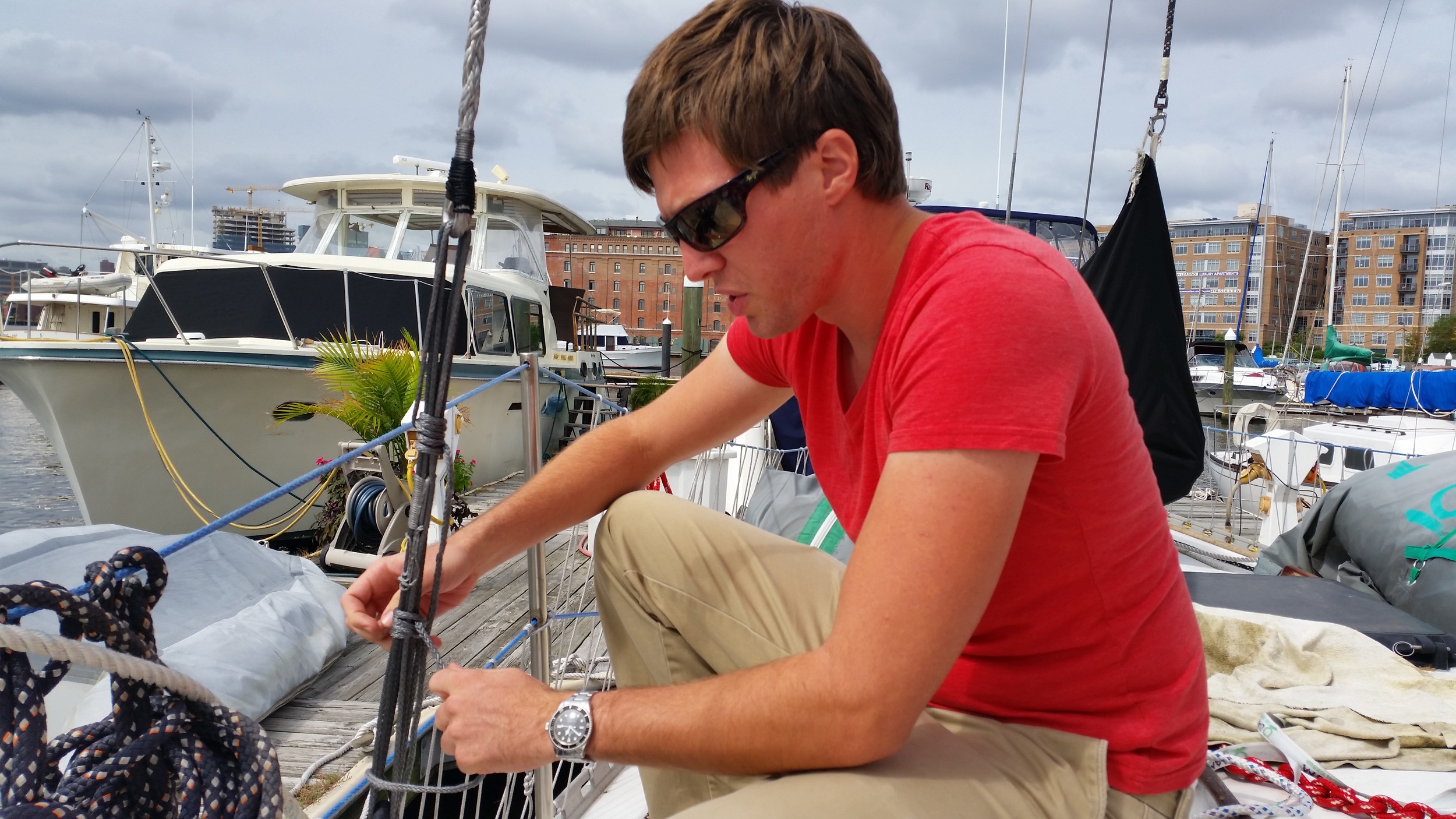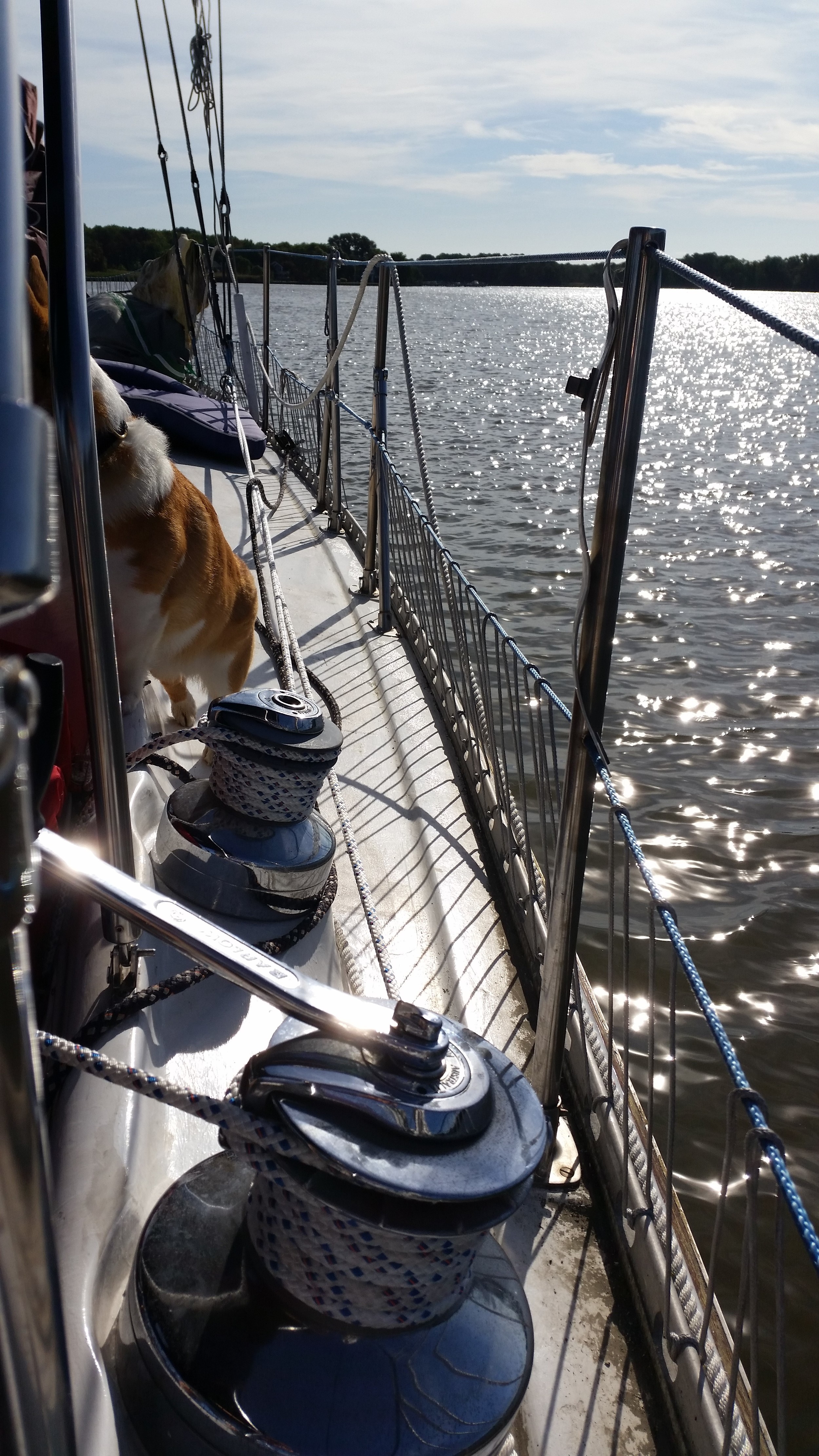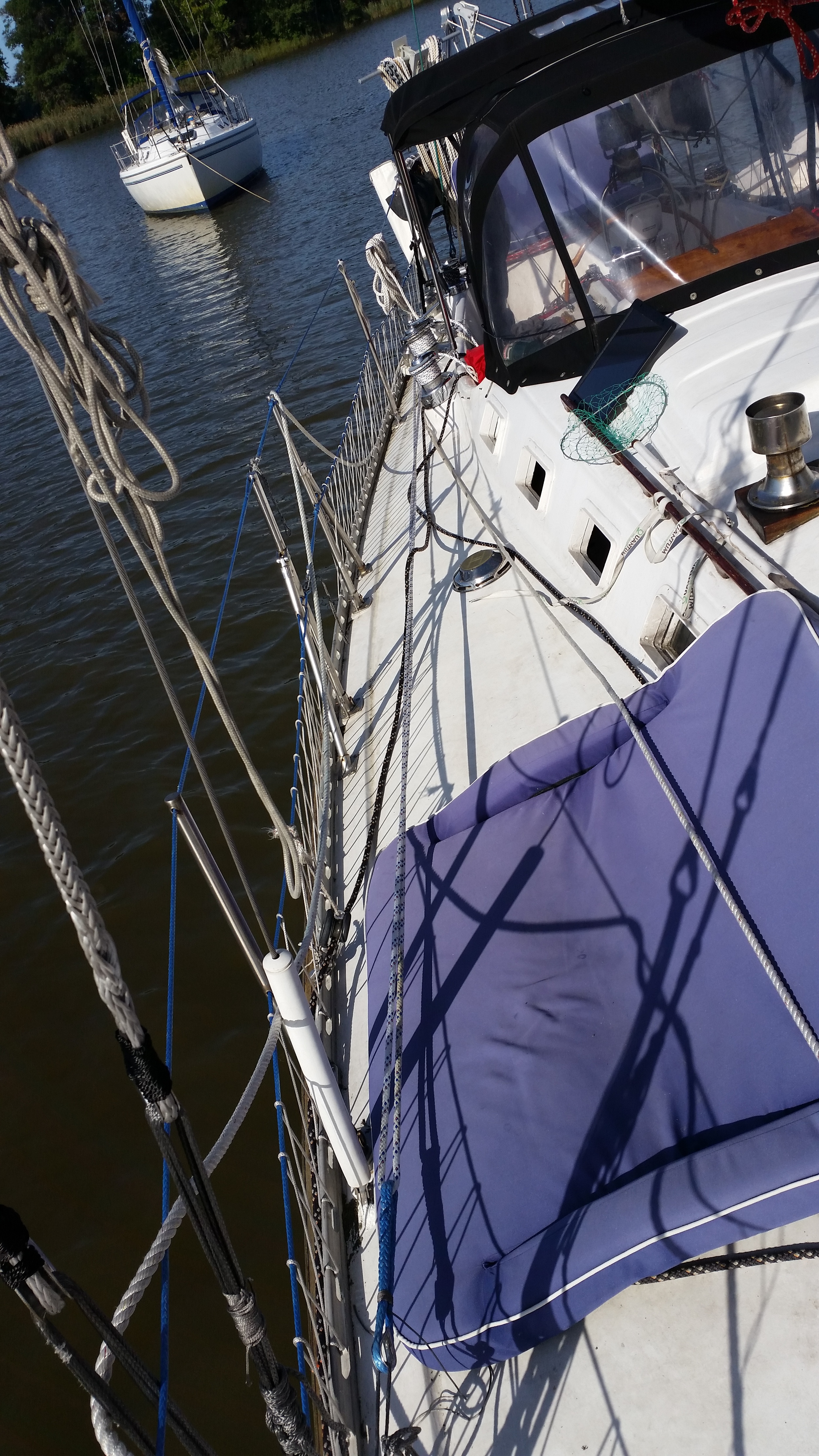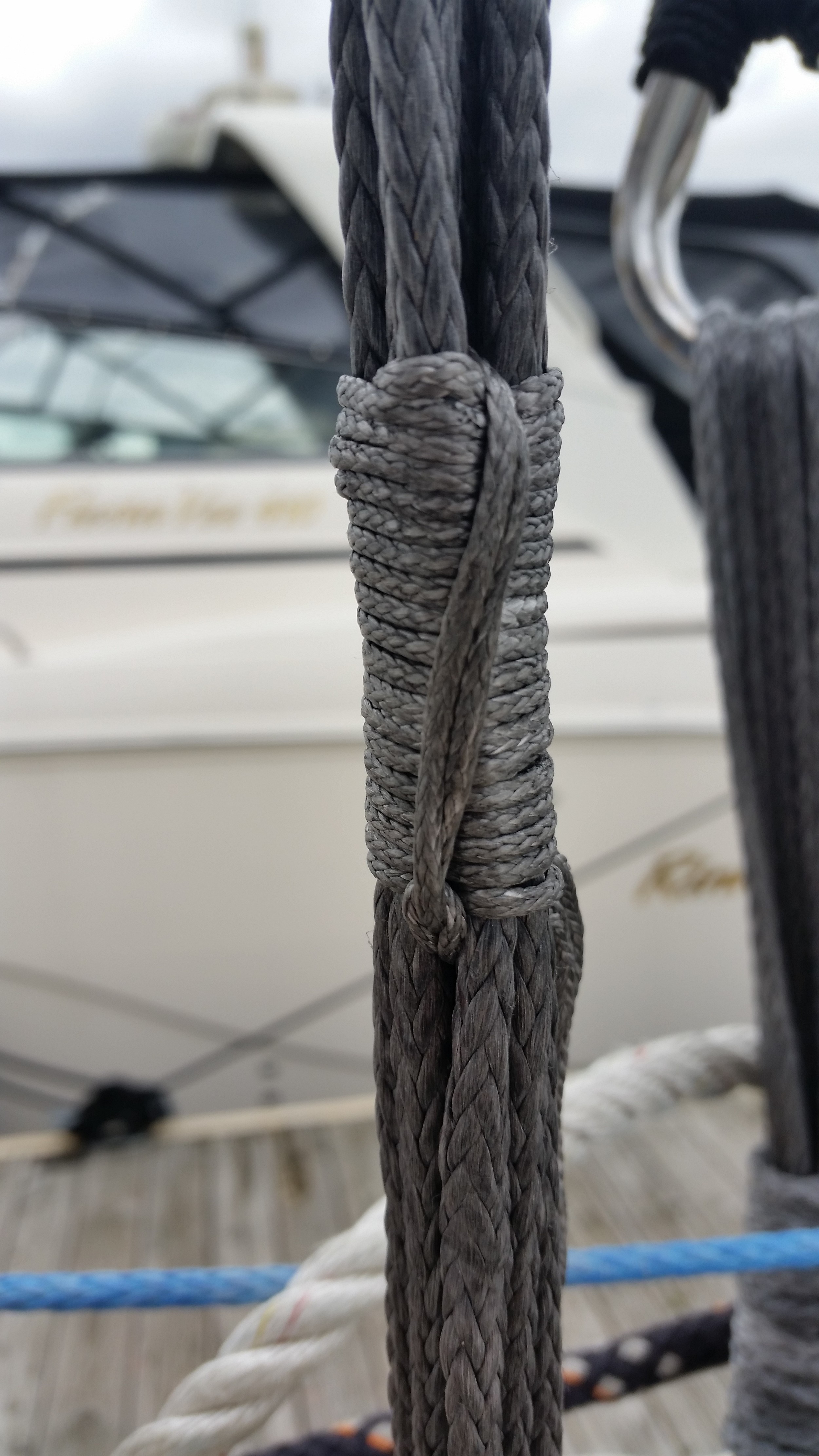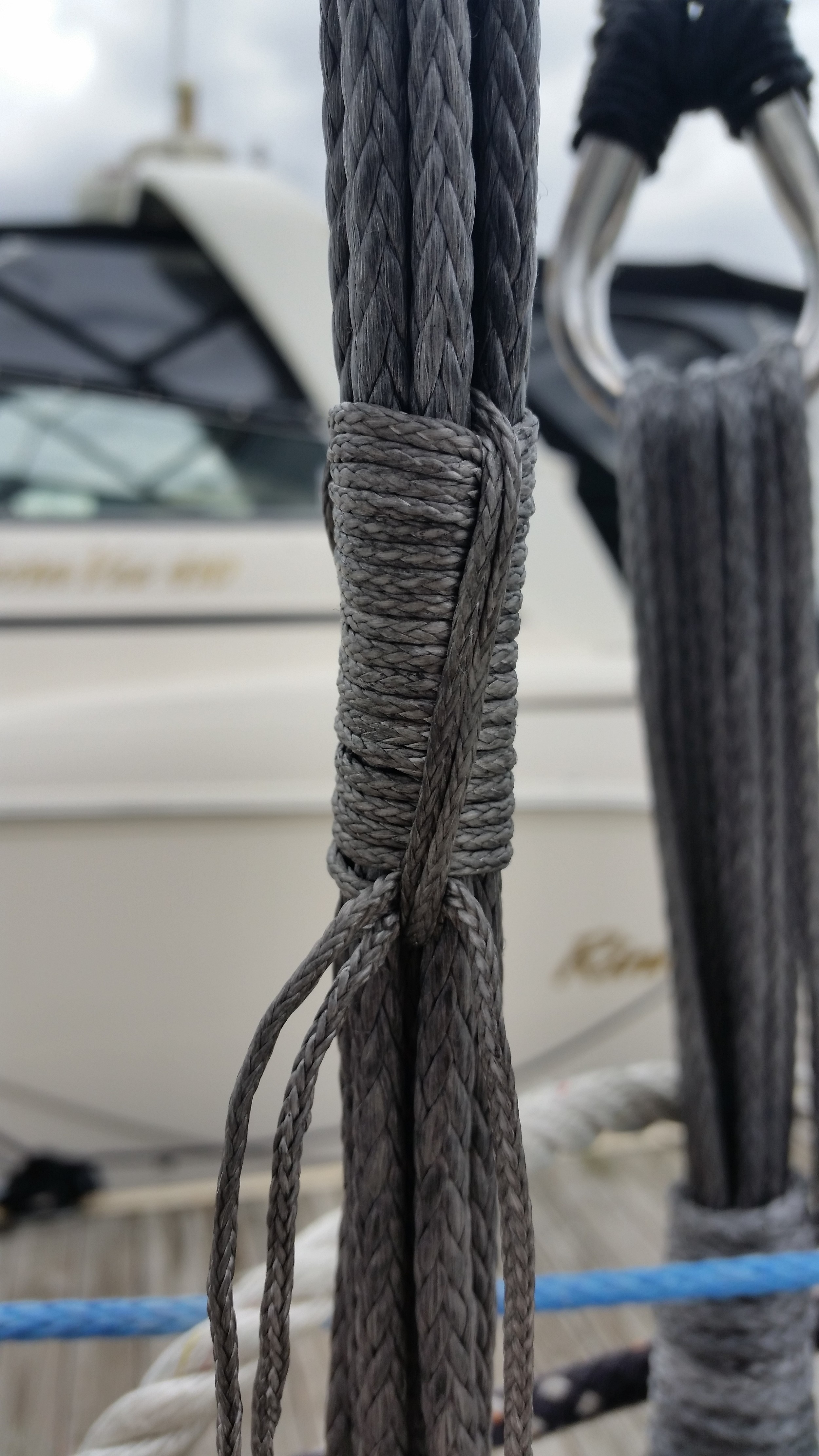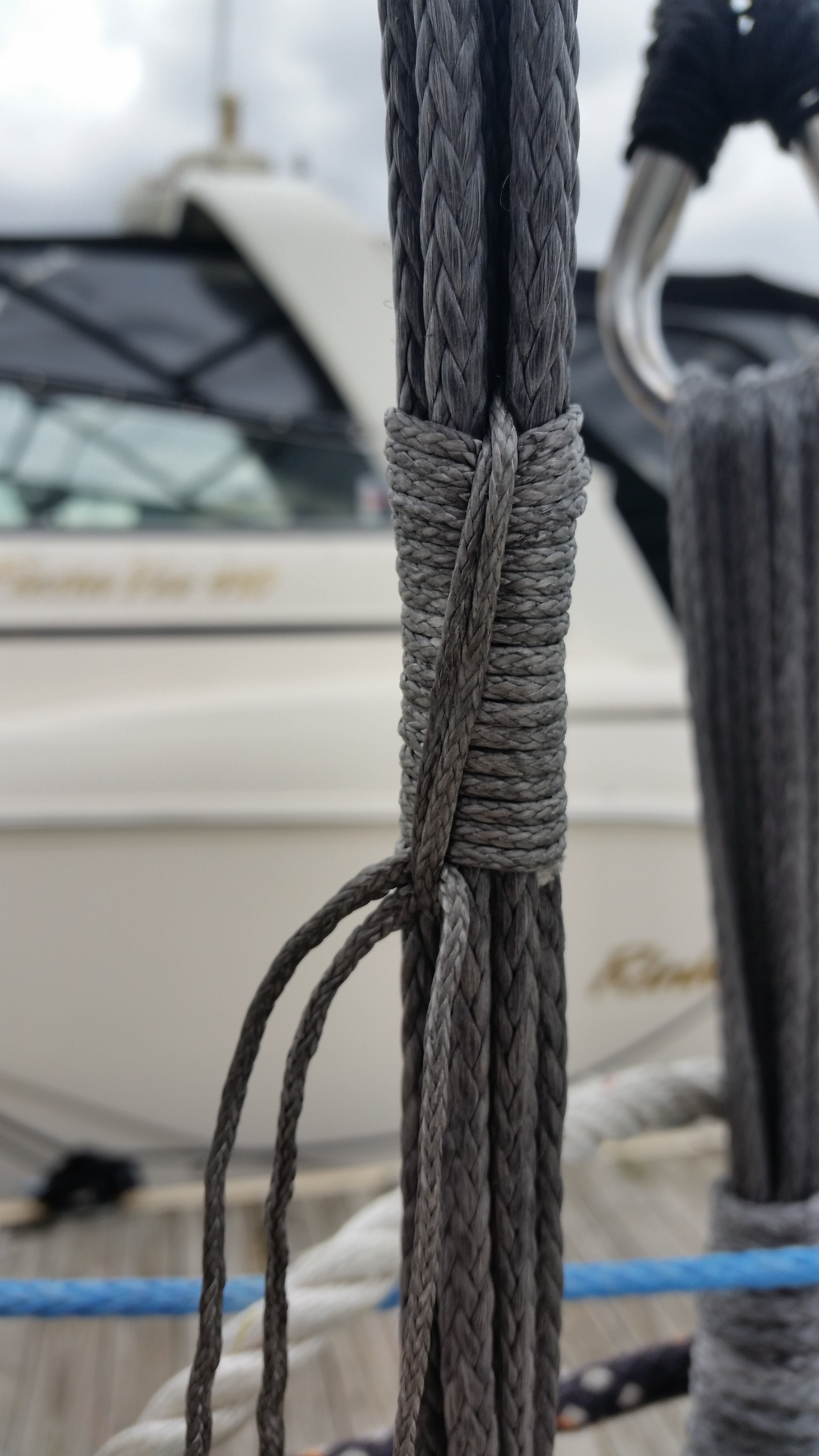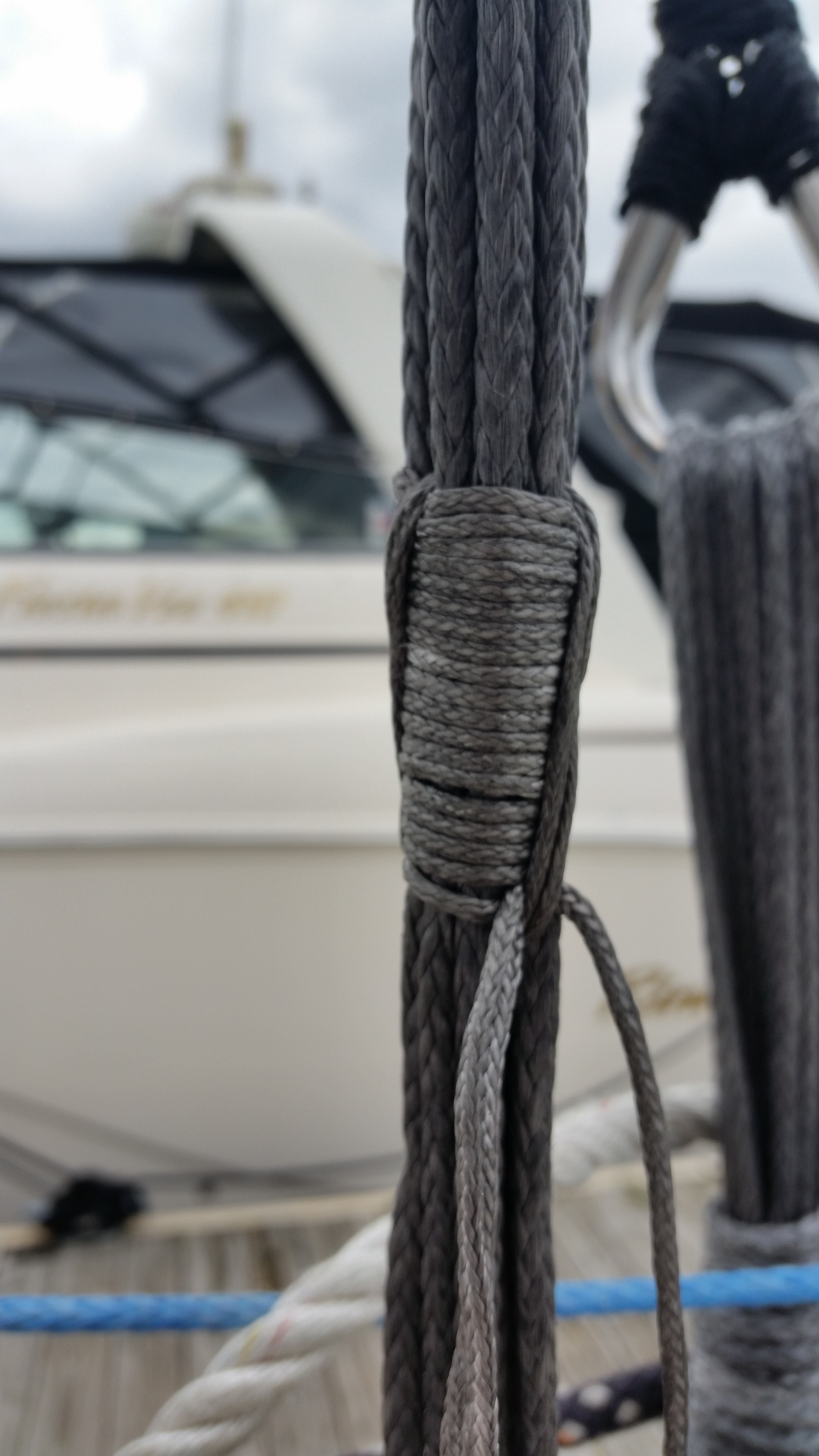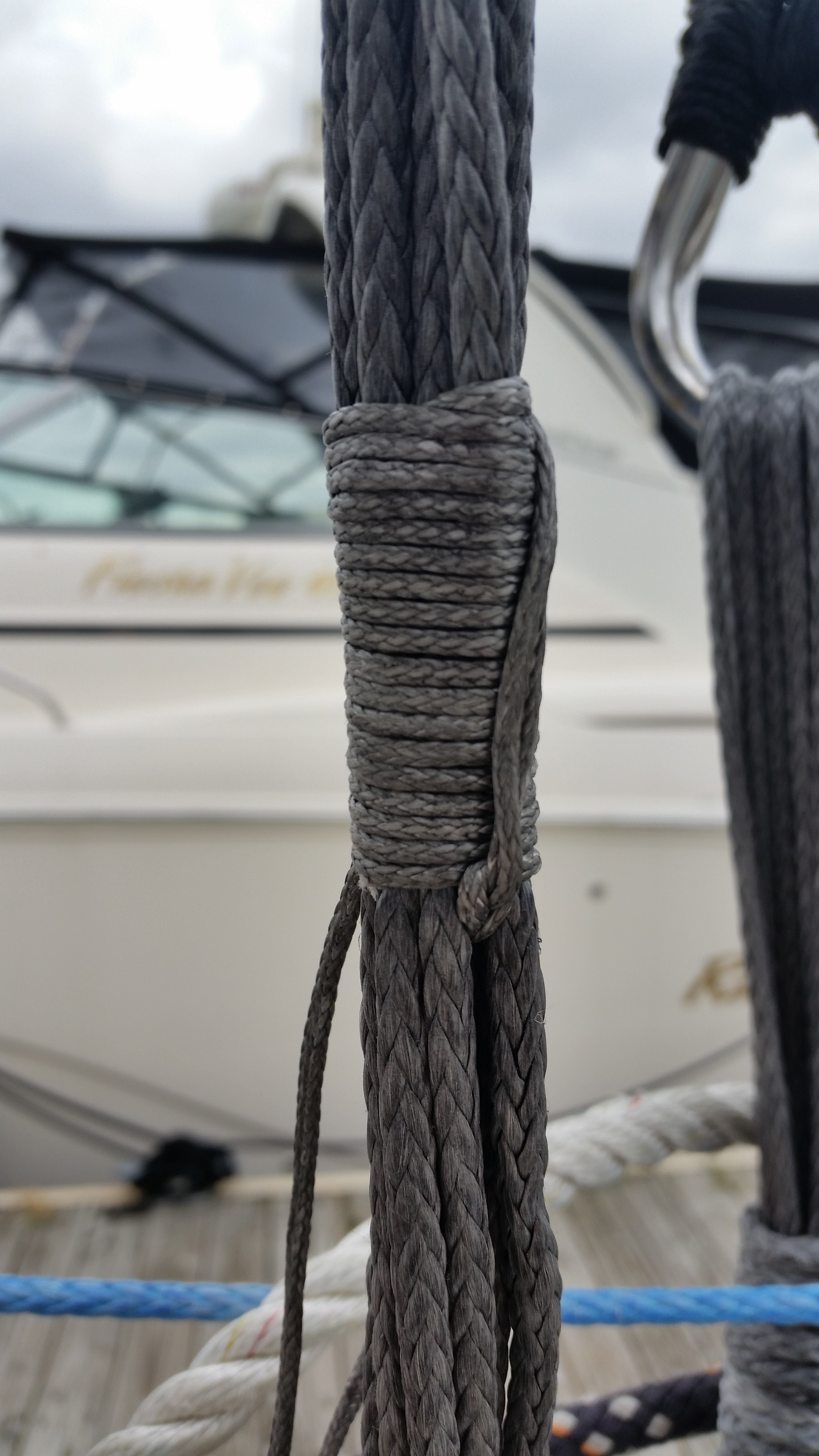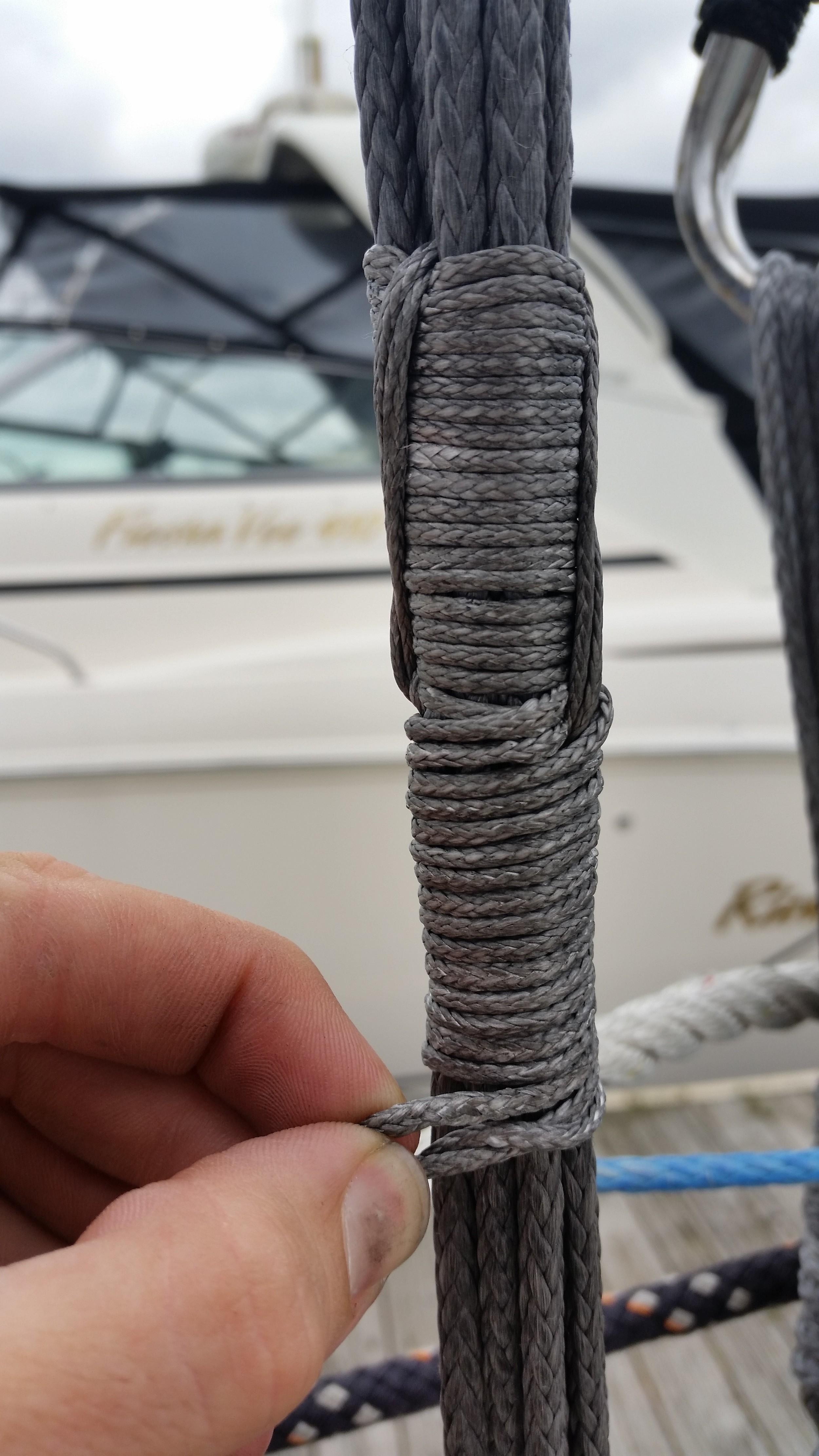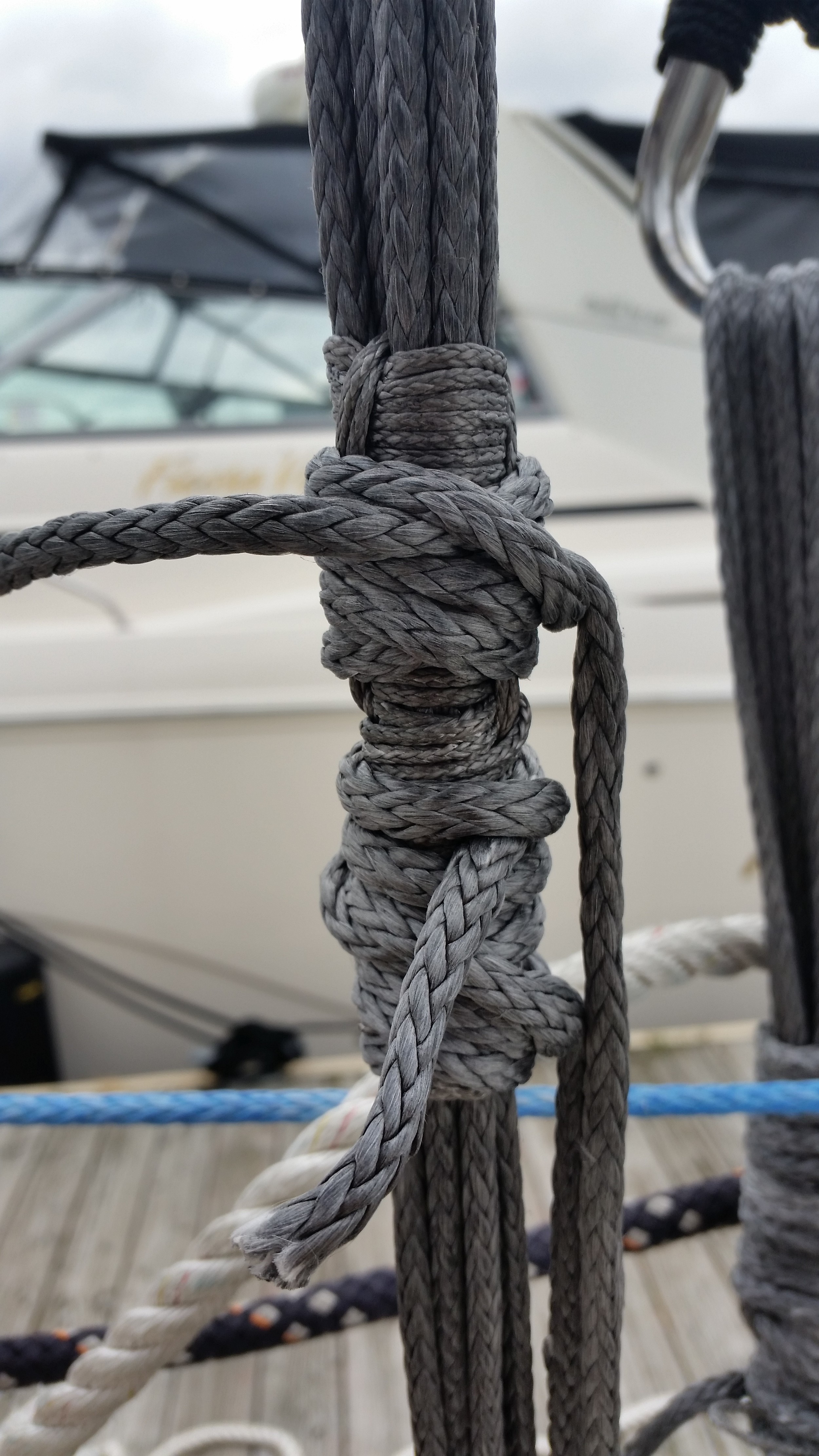The whole time, you want to make sure the mast stays in column. If it begins to bend or have an S curve to it, you need to correct that immediately or it will only get worse as the tuning progresses.
There are two ways to do this, depending on the situation. If this is new rigging being set up for the first time, you want to loosen everything and start from scratch. If it's not new rigging and merely a tune up, then you don't need to loosen everything before you start.
To start with the cap shrouds, you want to make sure that they keep the mast head centered over the boat. There are many complicated ways to do this, but the easiest way is to attach a jug of water to a halyard that comes out in the middle shiv on the back of the mast. Swing the jug to the port side, cleat the halyard, and mark where it hits the toe rail. Then swing it over to the starboard side and make sure it hits the same mark.
If the jug hangs lower to port, then the mast is tipped to port.
If the jug hangs lower to starboard, then the mast is tipped to starboard.
For example:
If the jug hangs lower on the port side, you want to tighten the starboard shroud and loosen the port shroud. Then check again with the jug to make sure it is all centered and even.
Once you have it centered, you need to begin tightening the cap shrouds. To do this, you want to have the identical purchase system set up on both sides. This means that if the starboard deadeye has 7 passes for the lashing, the port deadeye needs to have 7 as well. Otherwise, the whole system is thrown off.
How much to tighten the cap shrouds also depends on each boat. While some people will tune the rigging with a Loos gauge based on the specs from the boat manufacturer, they will not end up with a satisfactory result and will still need to do a final adjustment by eye and by feel. The boat manufacturer provides these numbers as a guideline for the ideal. In the ideal boat on a line drawing, the mast fittings and chainplates are never purely symmetrical. The slightest variation in placement on the real boat will make each stay have its own unique tension to keep the mast in column. For this reason, it is best to have a general idea of what amount of tension is required and then tune the rest by eye and by feel.
Back to tuning! You want to run the purchase system equally on both sides, to the same type of tensioning lines, to the same size of winches. You will begin grinding the winches, doing a the same number of cranks on each. As the tension builds, you will be able to feel it in the winch handle, so make sure that the force you feel is about equal on both sides.
When you think the tension is about adequate, you will want to re-check that the mast head is centered with the jug trick. If there is any variation, now is the time to correct this by tightening one side a bit more than the other to compensate and then re-check with the jug again.
One thing to keep in mind is that as you tension the cap shrouds, the spreaders will be pulled down slightly. This needs to be addressed at the end of the tuning process, but keep an eye on them as you tighten the cap shrouds to make sure they don't bend down and break. When you tighten the cap shrouds, they will only pull the spreader tips down a smidge, so it's not usually an issue mid tuning. Since spreaders are expensive, it's best to keep an eye on them.
Back to tuning again! To adjust by eye, you want to verify with the jug trick, then sight up the mast to make sure it's in column. Then to adjust by feel, you want to grab onto the cap shroud and give it a tug, a wiggle, and a snap. You will get a feel for what's right with time, it comes with experience. The idea is, you want to make sure it feels tight, but not as tight as a banjo string. If it is loose, it will not snap back into place when you wiggle and snap it around. If it is tight, it will not budge at all.
If this is your first time, ask some friends if you can feel how their rigging feels. This could give you an idea what you're looking for. The reason they call it "tuning" and not "setting" the standing rigging is because it is an art and a science. You will tune it up at the pier to what looks right, but you won't know for sure until you take it out sailing.
When under sail, you will want to once again go forward to the mast and sight it. With respect to the cap shrouds, you want to make sure that the mast looks straight and isn't bending to leeward. You want to go up on a port tack, as well as a starboard tack. This will tell you which shroud needs to be tightened.
On port tack, the port shroud should be tight, the mast straight, and the starboard shroud a little less tight. If the mast head is bent to leeward, the port shroud is too loose and should be tightened. If the mast is straight but the starboard shroud is loose and flopping around, the starboard shroud needs tightening. If the mast has a bend midway up, then that has to do with the lowers which will be discussed later.
After you do a test sail, you will know what needs to be tuned some more. Then you will tune it and take it out again. If you are 100% confident in your ability to tie perfect knots and are able to develop a large enough purchase system, you can actually tune the mast while under sail. I do this on my own sailboat and it saves a lot of time since I can get it set perfect while under sail and tested at the same time.
There are two ways to know you need to adjust your cap shrouds. One is by doing a quick rigging inspection where you go around and feel all the shrouds via the tug, wiggle, and snap. If they feel loose, it's time for an adjustment. The other way is by sailing and recognizing the characteristics of poorly tuned cap shrouds. The boat will heel much more than usual and will not point to windward very well. A simple mast sighting will confirm the loose cap shroud and let you know it's time for a tune up.
With synthetic standing rigging, you will need to do many tune ups when it is brand new. Dyneema has 3 phases that it goes through. Phase 1 is the beginning, phase 2 is the wonderful time when everything works wonderfully, phase 3 is the warning that the end is coming and needs to be replaced. We will also talk about the phases in the future.
During phase 1, the standing rigging will be creeping and go slack in a few days. When you first set it, it will be beautifully tuned! In a few days, it will be completely slack and desperately in need of tuning. I suggest tuning the rigging weekly during this stage right before you go sailing so that it's nicely set for your trip. Once in phase 2, this won't be a weekly occurrence, but it will still happen from time to time.
For a description of how to set up the rig tuning lines, please look over this post:





